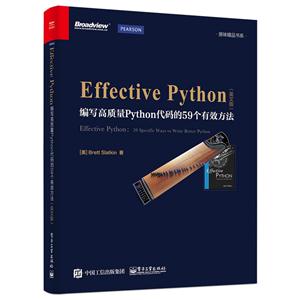扫一扫
关注中图网
官方微博
本类五星书更多>
-
>
全国计算机等级考试最新真考题库模拟考场及详解·二级MSOffice高级应用
-
>
决战行测5000题(言语理解与表达)
-
>
软件性能测试.分析与调优实践之路
-
>
第一行代码Android
-
>
C Primer Plus 第6版 中文版
-
>
深度学习
-
>
MATLAB计算机视觉与深度学习实战-赠在线交流卡和本书源码
Effective Python编写高质量Python代码的59个有效方法-(英文版) 版权信息
- ISBN:9787121272622
- 条形码:9787121272622 ; 978-7-121-27262-2
- 装帧:暂无
- 册数:暂无
- 重量:暂无
- 所属分类:>>
Effective Python编写高质量Python代码的59个有效方法-(英文版) 内容简介
本书不是要讲述 Python 的基础编程,而是要帮你掌握 Python 独特的优势和魅力。书中总结了 59个 Python 编程的优秀实践、贴士和捷径,并用真实代码示例进行了解释。全书共分 8 章,第 1 章讲述Python 的风格思想,介绍了 Python 中常见问题的推荐解决方案;第 2 章讲述如何使用 Python 函数来阐明意图、提升可重用性,并减少错误;第 3 章介绍如何使用类和继承来表达你对对象的预期行为;第4章介绍了使用这些元类和属性的常用语法;第5章讲述如何在并行和并发的场景下利用好Python;第 6 章讲述 Python 中必要的内置模块;第 7 章教你如何合作开发 Python 程序;第 8 章介绍如何使用Python 调试、优化和测试程序。
Effective Python编写高质量Python代码的59个有效方法-(英文版) 目录
前言
致谢
关于作者
Chapter 1: Pythonic Thinking
Item 1: Know Which Version of Python You're Using
Item 2: Follow the PEP 8 Style Guide
Item 3: Know the Differences Between bytes , str , and unicode
Item 4: Write Helper Functions Instead of Complex Expressions
Item 5: Know How to Slice Sequences
Item 6: Avoid Using start , end , and stride in a Single Slice
Item 7: Use List Comprehensions Instead of map and filter
Item 8: Avoid More Than Two Expressions in List Comprehensions
Item 9: Consider Generator Expressions for Large Comprehensions
Item 10: Prefer enumerate Over range
Item 11: Use zip to Process Iterators in Parallel
Item 12: Avoid else Blocks After for and while Loops
Item 13: Take Advantage of Each Block in try / except / else / finally
Chapter 2: Functions
Item 14: Prefer Exceptions to Returning None
Item 15: Know How Closures Interact with Variable Scope
Item 16: Consider Generators Instead of Returning Lists
Item 17: Be Defensive When Iterating Over Arguments
Item 18: Reduce Visual Noise with Variable Positional Arguments
Item 19: Provide Optional Behavior with Keyword Arguments
Item 20: Use None and Docstrings to Specify Dynamic Default Arguments
Item 21: Enforce Clarity with Keyword-Only Arguments
Chapter 3: Classes and Inheritance
Item 22: Prefer Helper Classes Over Bookkeeping with Dictionaries and Tuples
Item 23: Accept Functions for Simple Interfaces Instead of Classes
Item 24: Use @classmethod Polymorphism to Construct Objects Generically
Item 25: Initialize Parent Classes with super
Item 26: Use Multiple Inheritance Only for Mix-in Utility Classes
Item 27: Prefer Public Attributes Over Private Ones
Item 28: Inherit from collections.abc for Custom Container Types
Chapter 4: Metaclasses and Attributes
Item 29: Use Plain Attributes Instead of Get and Set Methods
Item 30: Consider @property Instead of Refactoring Attributes
Item 31: Use Descriptors for Reusable @property Methods
Item 32: Use __getattr__ , __getattribute__ , and __setattr__ for Lazy Attributes
Item 33: Validate Subclasses with Metaclasses
Item 34: Register Class Existence with Metaclasses
Item 35: Annotate Class Attributes with Metaclasses
Chapter 5: Concurrency and Parallelism
Item 36: Use subprocess to Manage Child Processes
Item 37: Use Threads for Blocking I/O, Avoid for Parallelism
Item 38: Use Lock to Prevent Data Races in Threads
Item 39: Use Queue to Coordinate Work Between Threads
Item 40: Consider Coroutines to Run Many Functions Concurrently
Item 41: Consider concurrent.futures for True Parallelism
Chapter 6: Built-in Modules
Item 42: Define Function Decorators with functools.wraps
Item 43: Consider contextlib and with Statements for Reusable try / finally Behavior
Item 44: Make pickle Reliable with copyreg
Item 45: Use datetime Instead of time for Local Clocks
Item 46: Use Built-in Algorithms and Data Structures
Item 47: Use decimal When Precision Is Paramount
Item 48: Know Where to Find Community-Built Modules
Chapter 7: Collaboration
Item 49: Write Docstrings for Every Function, Class, and Module
Item 50: Use Packages to Organize Modules and Provide Stable APIs
Item 51: Define a Root Exception to Insulate Callers from APIs
Item 52: Know How to Break Circular Dependencies
Item 53: Use Virtual Environments for Isolated and Reproducible Dependencies
Chapter 8: Production
Item 54: Consider Module-Scoped Code to Configure Deployment Environments
Item 55: Use repr Strings for Debugging Output
Item 56: Test Everything with unittest
Item 57: Consider Interactive Debugging with pdb
Item 58: Profile Before Optimizing
Item 59: Use tracemalloc to Understand Memory Usage and Leaks
Index
展开全部
书友推荐
- >
巴金-再思录
巴金-再思录
¥33.1¥46.0 - >
自卑与超越
自卑与超越
¥13.5¥39.8 - >
罗曼·罗兰读书随笔-精装
罗曼·罗兰读书随笔-精装
¥40.6¥58.0 - >
诗经-先民的歌唱
诗经-先民的歌唱
¥15.1¥39.8 - >
小考拉的故事-套装共3册
小考拉的故事-套装共3册
¥36.7¥68.0 - >
山海经
山海经
¥20.4¥68.0 - >
随园食单
随园食单
¥20.6¥48.0 - >
中国人在乌苏里边疆区:历史与人类学概述
中国人在乌苏里边疆区:历史与人类学概述
¥24.0¥48.0
本类畅销
-
参数化逻辑构建过程
¥34.2¥118 -
构建之法
¥48.3¥69 -
App Inventor趣味游戏编程
¥34.8¥43 -
区块链开发从入门到精通 以太坊+超级账本
¥55.9¥79.8 -
App Inventor创意趣味编程
¥27.3¥39 -
2022图书×抽奖盲袋
¥9.9¥25
















